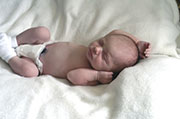
WEDNESDAY, Aug. 14 (HealthDay News) — A trial comparing two types of noninvasive breathing treatments for premature infants has found them similarly effective — but less likely to prevent severe lung injury than previously thought.
The study, which compared nasal continuous positive airway pressure and nasal intermittent positive-pressure ventilation, found that the rates of complications for the two treatments were about the same.
“The two treatments really have no great benefits above each other. They’re equivalent,” said the study’s lead author, Dr. Haresh Kirpalani, a professor of pediatrics in the division of neonatology at the Children’s Hospital of Philadelphia.
Babies born prematurely often need help breathing until their lungs develop more fully. Traditionally, this was done by inserting a tube into a baby’s airway and using a mechanical ventilator to breathe for the baby. However, these devices can cause airway inflammation and lung injuries in preemies, according to background information in the study, published in the Aug. 15 issue of the New England Journal of Medicine.
Whenever possible, doctors prefer to use noninvasive methods to help premature babies breathe. Continuous positive airway pressure (CPAP) is the current standard of noninvasive care, Kirpalani said. Using a mask with nasal prongs, CPAP works by providing continuous air pressure that keeps the lungs from collapsing when a baby breathes out. This device is similar to what adults with sleep apnea use to keep their airways open at night.
Intermittent positive-pressure ventilation (IPPV) is like continuous positive airway pressure with extra breaths, said Dr. Deborah Campbell, director of neonatology at the Children’s Hospital at Montefiore in New York City. “With tiny babies, an issue is lung immaturity and muscle fatigue in terms of breathing. By blowing breaths in, the IPPV reduces the work of breathing,” she explained.
Before this study’s findings, it appeared that babies on IPPV seemed to do a little bit better than kids on CPAP, she said.
The current study compared more than 1,000 infants who were randomly assigned to either method to see which was better for preventing bronchopulmonary dysplasia, a complication that occurs when the lungs become inflamed or scarred. The babies were all born at less than 30 weeks of gestation and weighed less than 1,000 grams at birth, according to the study.
At the end of the study, complete data was available on 987 babies: 497 who received nasal IPPV and 490 who received nasal CPAP.
Within three months of birth, about 38 percent of the babies who received IPPV had died or survived with bronchopulmonary dysplasia. In the CPAP group, nearly 37 percent died or survived with bronchopulmonary dysplasia. The groups had similar rates of conversion to intubation and mechanical ventilation, the study authors noted.
“These babies are extremely sick, and have a very high rate of death even in the best of times. The deaths weren’t really related to the treatment. But what we showed was that compared to the standard of care — CPAP — IPPV didn’t show any greater magnitude of efficacy,” Kirpalani said.
“Proponents of IPPV would probably say that we’ve not shown any harm with IPPV, but we don’t see that it confers any meaningful benefits either,” said Kirpalani.
The researchers are currently performing a cost analysis of the two treatments, but Kirpalani said he believes IPPV is probably more expensive, and if it is more expensive, “there needs to be a compelling reason to use it, and we don’t see that compelling reason right now,” he added.
Campbell said it was good to see that the treatments were similarly effective and similarly safe. But, she said she doesn’t believe this study is the final word on IPPV either. “They looked at death and survival with lung disease, but they don’t tease out the severity of lung disease. And, it’s important to know if the kids who got nasal IPPV have less severe chronic lung disease,” she said.
In addition, she said that she didn’t think this study’s findings will lead anyone to change their preferences just yet. “Proponents of CPAP alone will continue to use that, and those who believe there’s a benefit to IPPV will likely continue to use that, particularly since there was no increased harm seen with this modality,” said Campbell.
More information
Learn more about preemies’ lung complications from the Nemours Foundation.
Copyright © 2025 HealthDay. All rights reserved.

